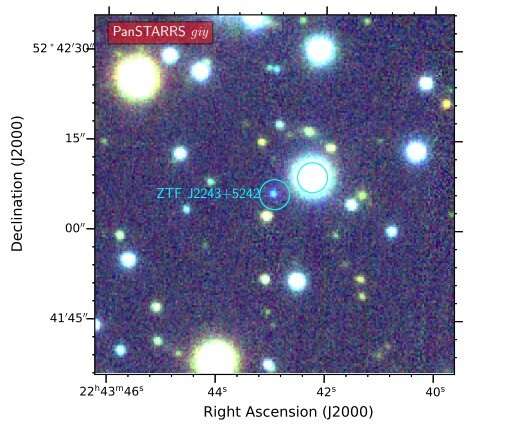Pan-STARRS1 color giy-bands image of ZTF J2243+5242, which is the blue object in the center of the image. Credit: Burdge et al., 2020.
Astronomers from the California Institute of Technology and elsewhere report the detection of a new eclipsing detached double white dwarf binary. The system, designated ZTF J2243+5242 has an orbital period of below 10 minutes, which makes it one of the shortest-period eclipsing binaries known to date. The finding is detailed in a paper published October 7 on arXiv.org.
Astronomers are interested in finding and studying double white dwarfs (DWDs), as their mergers are believed to produce new white dwarfs with higher masses. It is assumed that some high-mass white dwarfs in the solar neighborhood could be DWD merger products.
The Zwicky Transient Facility (ZTF), using the Palomar Observatory in California, is one of the most important astronomical surveys to search for double white dwarf binary systems. So far, it has identified many close DWDs, with orbital periods under an hour.
Now, a team of astronomers led by Caltech's Kevin B. Burdge has found a new double white dwarf from the ZTF survey. Its nature was confirmed by follow-up photometric and spectroscopic observations.
"Here, we described the discovery and characterization of ZTF J2243+5242, the second eclipsing binary known with an orbital period under 10 minutes," the astronomers wrote in the paper.
ZTF J2243+5242 has an orbital period of 8.8 minutes and consists of two low-mass helium white dwarfs. The two components have radii of about 0.03 solar radii, while their masses are approximately 0.35 and 0.38 solar masses. The more massive white dwarf has an effective temperature of around 16,200 K and its companion is some 6,000 K hotter. The binary is estimated to be located about 6.9 million light years away from the Earth.
The authors of the paper assume that in about 400,000 years from now, the two WDs of ZTF J2243+5242 will merge, most likely to form an isolated hot subdwarf or an R Coronae Borealis star. They added that ZTF J2243+5242 is currently undergoing rapid orbital decay.
According to the study, the system is currently clearly detached, however, the two components will start interacting in approximately 320,000 years.
The scientists expect that after the merger, ZTF J2243+5242 will be one of the strongest gravitational wave sources detectable by space-based gravitational-wave detectors like ESA's Laser Space Interferometer Antenna (LISA).
"In the era of LISA, short orbital period systems like ZTF J2243+5242 and ZTF J1539+5027 will be particularly valuable astrophysical laboratories. Because these systems fall near the peak of LISA's sensitivity, they are detectable at large distances," the researchers explained.
Summing up the results, Burdge's team underlined that their study demonstrates the considerable value of photometry not just as a tool for discovering extreme systems like ZTF J2243+5242, but also a technique which can be used to precisely characterize these objects at great distances and faint apparent magnitudes.
More information: An 8.8 minute orbital period eclipsing detached double white dwarf binary, arXiv:2010.03555 [astro-ph.SR] arxiv.org/abs/2010.03555
© 2020 Science X Network
























